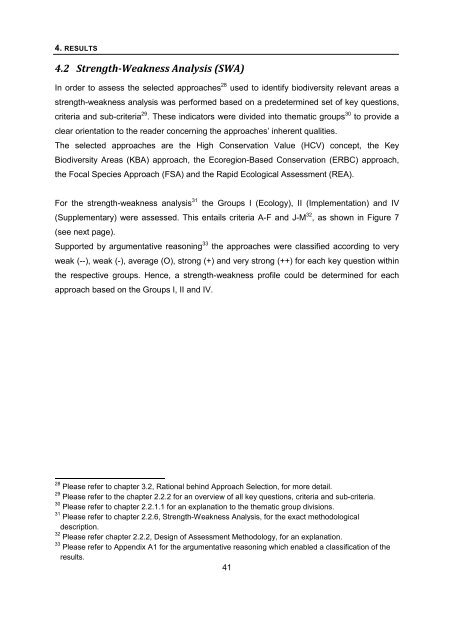Assessment of approaches to identify areas with special importance ...
Assessment of approaches to identify areas with special importance ...
Assessment of approaches to identify areas with special importance ...
You also want an ePaper? Increase the reach of your titles
YUMPU automatically turns print PDFs into web optimized ePapers that Google loves.
4. RESULTS<br />
4.2 Strength-Weakness Analysis (SWA)<br />
In order <strong>to</strong> assess the selected <strong>approaches</strong> 28 used <strong>to</strong> <strong>identify</strong> biodiversity relevant <strong>areas</strong> a<br />
strength-weakness analysis was performed based on a predetermined set <strong>of</strong> key questions,<br />
criteria and sub-criteria 29 . These indica<strong>to</strong>rs were divided in<strong>to</strong> thematic groups 30 <strong>to</strong> provide a<br />
clear orientation <strong>to</strong> the reader concerning the <strong>approaches</strong>’ inherent qualities.<br />
The selected <strong>approaches</strong> are the High Conservation Value (HCV) concept, the Key<br />
Biodiversity Areas (KBA) approach, the Ecoregion-Based Conservation (ERBC) approach,<br />
the Focal Species Approach (FSA) and the Rapid Ecological <strong>Assessment</strong> (REA).<br />
For the strength-weakness analysis 31 the Groups I (Ecology), II (Implementation) and IV<br />
(Supplementary) were assessed. This entails criteria A-F and J-M 32 , as shown in Figure 7<br />
(see next page).<br />
Supported by argumentative reasoning 33 the <strong>approaches</strong> were classified according <strong>to</strong> very<br />
weak (--), weak (-), average (O), strong (+) and very strong (++) for each key question <strong>with</strong>in<br />
the respective groups. Hence, a strength-weakness pr<strong>of</strong>ile could be determined for each<br />
approach based on the Groups I, II and IV.<br />
28 Please refer <strong>to</strong> chapter 3.2, Rational behind Approach Selection, for more detail.<br />
29 Please refer <strong>to</strong> the chapter 2.2.2 for an overview <strong>of</strong> all key questions, criteria and sub-criteria.<br />
30 Please refer <strong>to</strong> chapter 2.2.1.1 for an explanation <strong>to</strong> the thematic group divisions.<br />
31 Please refer <strong>to</strong> chapter 2.2.6, Strength-Weakness Analysis, for the exact methodological<br />
description.<br />
32 Please refer chapter 2.2.2, Design <strong>of</strong> <strong>Assessment</strong> Methodology, for an explanation.<br />
33 Please refer <strong>to</strong> Appendix A1 for the argumentative reasoning which enabled a classification <strong>of</strong> the<br />
results.<br />
41

















